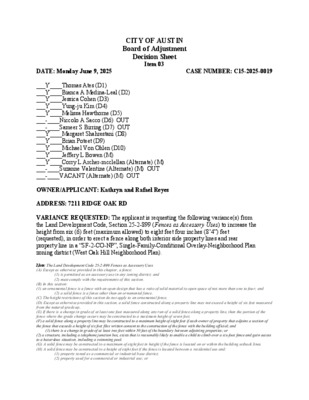ITEM03 C15-2025-0019 DENIED DS — original pdf
Backup

CITY OF AUSTIN Board of Adjustment Decision Sheet Item 03 DATE: Monday June 9, 2025 CASE NUMBER: C15-2025-0019 ___Y____Thomas Ates (D1) ___Y____Bianca A Medina-Leal (D2) ___Y____Jessica Cohen (D3) ___Y____Yung-ju Kim (D4) ___Y____Melissa Hawthorne (D5) ___-____Niccolo A Sacco (D6) OUT ___-____Sameer S Birring (D7) OUT ___Y____Margaret Shahrestani (D8) ___Y____Brian Poteet (D9) ___Y____Michael Von Ohlen (D10) ___Y____Jeffery L Bowen (M) ___Y____Corry L Archer-mcclellan (Alternate) (M) ___-____Suzanne Valentine (Alternate) (M) OUT ___-____VACANT (Alternate) (M) OUT OWNER/APPLICANT: Kathryn and Rafael Reyes ADDRESS: 7211 RIDGE OAK RD VARIANCE REQUESTED: The applicant is requesting the following variance(s) from the Land Development Code, Section 25-2-899 (Fences as Accessory Uses) to increase the height from six (6) feet (maximum allowed) to eight feet four inches (8’4”) feet (requested), in order to erect a fence along both interior side property lines and rear property line in a “SF-2-CO-NP”, Single-Family-Conditional Overlay-Neighborhood Plan zoning district (West Oak Hill Neighborhood Plan). Note: The Land Development Code 25-2-899 Fences as Accessory Uses (A) Except as otherwise provided in this chapter, a fence: (1) is permitted as an accessory use in any zoning district; and (2) must comply with the requirements of this section. (B) In this section: (1) an ornamental fence is a fence with an open design that has a ratio of solid material to open space of not more than one to four; and (2) a solid fence is a fence other than an ornamental fence. (C) The height restrictions of this section do not apply to an ornamental fence. (D) Except as otherwise provided in this section, a solid fence constructed along a property line may not exceed a height of six feet measured from the natural grade up. (E) If there is a change in grade of at least one foot measured along any run of a solid fence along a property line, then the portion of the fence where the grade change occurs may be constructed to a maximum height of seven feet. (F) a solid fence along a property line may be constructed to a maximum height of eight feet if each owner of property that adjoins a section of the fence that exceeds a height of six feet files written consent to the construction of the fence with the building official; and (1) there is a change in grade of at least two feet within 50 feet of the boundary between adjoining properties; or (2) a structure, including a telephone junction box, exists that is reasonably likely to enable a child to climb over a six-foot fence and gain access to a hazardous situation, including a swimming pool. (G) A solid fence may be constructed to a maximum of eight feet in height if the fence is located on or within the building setback lines. (H) A solid fence may be constructed to a height of eight feet if the fence is located between a residential use and: (1) property zoned as a commercial or industrial base district; (2) property used for a commercial or industrial use; or (3) an alley that separates a residential use and: (a) property zoned as a commercial or industrial base district; or (b) property used for a commercial or industrial use. (I) Except as provided in Paragraph (1), a fence shall be constructed in accordance with this subsection. (1) This subsection does not apply to a fence that: (a) was constructed before July 31, 2023; or (b) is more than six feet in height and located on a property with a non-residential use. (2) When more than 50 percent of the total linear distance of an existing fence is replaced, the entire fence must comply with this subsection. (3) For new or replacement fences that follow historic design standards, this subsection will control if there is a conflict with the historic design standards. (4) A fence may not include: (a) spiked pickets, spiked bars, or other spiked decorative elements above the top horizontal backer rail; (b) vertical pickets above the top horizontal backer rail if the vertical pickets are separated by more than two inches and less than nine inches; (c) razor-like wire; or (d) barbed wire unless the fence is enclosing an airport or other landing area for aircraft and the use of barbed wire is required by Federal Aviation Administration regulation. (5) A fence that creates a substantial risk of entrapment or impalement is prohibited. (6) A solid chain link fence shall use knuckle selvage. (J) A fence used as a swimming pool barrier shall comply with Chapter 25-12, Article 14 (Swimming Pool and Spa Code). Source: Section 13-2-308; Ord. 990225-70; Ord. 031211-11; Ord. 050127-64; Ord. No. 20141120-181, Pt. 1, 12-1-14; Ord. No. 20230720-156, Pt. 2, 7-31-23. BOARD’S DECISION: The public hearing was closed by Madam Chair Jessica Cohen, Board member Michael Von Ohlen’s motion to Deny; Vice-chair Melissa Hawthorne second on 10-0 votes; DENIED. FINDING: 1. The Zoning regulations applicable to the property do not allow for a reasonable use because: 2. (a) The hardship for which the variance is requested is unique to the property in that: (b) The hardship is not general to the area in which the property is located because: 3. The variance will not alter the character of the area adjacent to the property, will not impair the use of adjacent conforming property, and will not impair the purpose of the regulations of the zoning district in which the property is located because: Elaine Ramirez Executive Liaison Jessica Cohen Madam Chair for